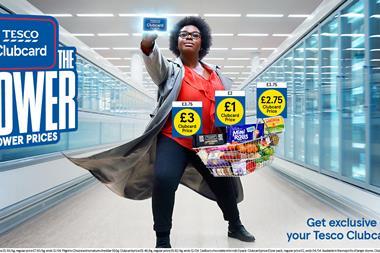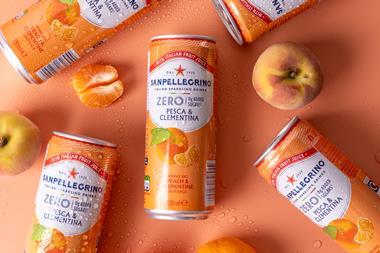Forecourts face a challenging year as the UK’s big food retailers move up a gear with expansion plans, says Siân Harrington
Petrol forecourts are shaping up to be the big battleground for the multiples this year. Last week, Tesco chief executive Sir Terry Leahy said he was earmarking some of the £778m raised through a share placement for expansion of convenience format Express, the first of which opens on an Esso forecourt in Thornton Heath, south London, next month.
Two months ago, Sainsbury announced plans to open 100 Local c-stores on Shell forecourts following a successful trial with its joint venture partner on six sites. The first of the new tranche opened in November at Battersea, south-west London.
Meanwhile, M& S is assessing its options with a motorway service station trial and Waitrose has announced that it is to open its first forecourt. Safeway and BP aside, everyone is ramping up their expansion programmes. But will the petrol companies prove willing allies?
It’s not difficult to see where the attraction lies for the multiples. According to Sir Peter Davis, group chief executive of Sainsbury, 17 of the company’s top 20 performing stores in terms of sales per square foot are operated under its convenience fascia Local. Of these, three are located on Shell forecourts.
“By working with Shell we can bring Sainsbury’s convenience food shopping into new areas of the UK and within easy reach of millions of new customers,” he says.
IGD research shows that the forecourt share of the convenience sector is growing. In 2003 87% of forecourt sites were true convenience stores compared to 84% in 2002 and 77% in 2001.
Market trends make such sites attractive to supermarkets. Car ownership continues to rise while the trend to convenience shows no sign of abating. Forecourt stores cater for busy lifestyles, with their easy access and long hours. On top of this, the food multiples are battling for good sites as they ramp up expansion of convenience offers in the light of a restrictive planning regime.
But the oil companies need to shape up if they are to make a go of it, warns Andy Thornton, managing director of convenience specialist Srcg. “Oil companies could be the biggest c-retailers in the world tomorrow if they took their blinkers off. The time when they decide to seriously invest in real c-stores or leave the market is nearly here. Their retail teams must develop a credible alternative to big box players or their boards may lose patience and divest their retail divisions.”
The entry of food retailers into the sector has upped the ante as the oil companies attempt to move from petrol retailers with a convenience store to convenience stores with petrol. They now face the challenge of having to turn stores into the profit centres.
n Tesco Express: total sales will be close to £1.5bn annualised by end of 2004 (includes standalone sites)
n Shell: 100 of 663 co-owned sites move to Sainsbury. These are likely to be among the better sites in Shell’s portfolio
n Exxon: will introduce ‘On-the-run’ to 100 stores by end of 2004. These will either be franchise or could be operated by Tesco
n M& S: will agree joint venture to sell product elsewhere, probably with oil company
n Another major oil company will pass on 250 stores to a big box player
Ray Holloway, director of the Petrol Retailers Association, says: “Petrol, which is 80% of their turnover, accounts for less than 20% of their income. The other 20% of their turnover accounts for 80% of income - and that’s predominantly from grocery sales. The trouble with petrol is tax - it eats up profit.”
Their culture is a major stumbling block. Research from Srcg shows that, while the oil companies move into c-retailing was seen as the fourth biggest single opportunity in the sector, company culture was also seen as the fourth biggest challenge.
The situation is not helped by the complex retail structure of the sector (see below). “Difficulties with the franchise system - multiple dealership structures with different supply chains - make it difficult to optimise the value chain and for manufacturers to develop the retailer as one account,” says Thornton.
Supply side availability is vital, agrees one analyst, pointing to high sales densities of around £30-£40 per sq ft in successful stores. Here the oil companies are fighting the sophisticated supermarket supply chains. Tesco uses its existing chain while Sainsbury has developed a specialised chain for servicing Local stores. Both approaches have ensured a regular supply, especially in fresh.
“There is no doubt that whenever a supermarket puts a store on a forecourt it sees four times the turnover on average,” says Mike Greene, chief executive of Harris International Marketing. “The main difference is fresh. When Sainsbury changed the offer on Shell the penetration of perishables rose from 6% to 60%,” he says.
Spar UK forecourt specialist Peter Creak agrees that chilled is important, although other categories are performing well. “Some of the biggest growth areas in Spar forecourts are chilled and frozen food, alcohol, fast food, crisps and snacks,” he says.
To develop a fresh-based offer the minimum requirement is 2,000-3,000 sq ft, says Greene. “Unless oil companies knock down the car wash and rebuild the site, this restricts their possibilities to about 10% of their estates,” he says.
And they do not have the credibility in fresh and chilled. “One of the big challenges is to get shoppers to buy food in petrol stations,” says Thornton. “Oily rags and pies do not go together. As more brands appear on the sites, this problem disappears.”
So will the market be dominated by the supermarkets - or will it fragment into different formats allowing the petrol companies to thrive with a different offer?
Greene believes that, although fresh is important, the market will segment more. “There was a feeling it would all be Tesco Express ‘me-toos’, all about fresh. Now there is segmentation, with growing fresh, food-service and CTN-type stores. Five years ago sandwiches were not in the top 10 in terms of forecourt penetration, now they are.”
Ultimately, the changes being wrought by supermarkets could benefit all forecourt operators. “As they are more heavily involved they bring their supply chain infrastructures,” says Greene. “Manufacturers put better people into serving the sector. They get a greater understanding, which will benefit all.”
Forecourt predictions 2004
>>how the sector will grow
Petrol forecourts are shaping up to be the big battleground for the multiples this year. Last week, Tesco chief executive Sir Terry Leahy said he was earmarking some of the £778m raised through a share placement for expansion of convenience format Express, the first of which opens on an Esso forecourt in Thornton Heath, south London, next month.
Two months ago, Sainsbury announced plans to open 100 Local c-stores on Shell forecourts following a successful trial with its joint venture partner on six sites. The first of the new tranche opened in November at Battersea, south-west London.
Meanwhile, M& S is assessing its options with a motorway service station trial and Waitrose has announced that it is to open its first forecourt. Safeway and BP aside, everyone is ramping up their expansion programmes. But will the petrol companies prove willing allies?
It’s not difficult to see where the attraction lies for the multiples. According to Sir Peter Davis, group chief executive of Sainsbury, 17 of the company’s top 20 performing stores in terms of sales per square foot are operated under its convenience fascia Local. Of these, three are located on Shell forecourts.
“By working with Shell we can bring Sainsbury’s convenience food shopping into new areas of the UK and within easy reach of millions of new customers,” he says.
IGD research shows that the forecourt share of the convenience sector is growing. In 2003 87% of forecourt sites were true convenience stores compared to 84% in 2002 and 77% in 2001.
Market trends make such sites attractive to supermarkets. Car ownership continues to rise while the trend to convenience shows no sign of abating. Forecourt stores cater for busy lifestyles, with their easy access and long hours. On top of this, the food multiples are battling for good sites as they ramp up expansion of convenience offers in the light of a restrictive planning regime.
But the oil companies need to shape up if they are to make a go of it, warns Andy Thornton, managing director of convenience specialist Srcg. “Oil companies could be the biggest c-retailers in the world tomorrow if they took their blinkers off. The time when they decide to seriously invest in real c-stores or leave the market is nearly here. Their retail teams must develop a credible alternative to big box players or their boards may lose patience and divest their retail divisions.”
The entry of food retailers into the sector has upped the ante as the oil companies attempt to move from petrol retailers with a convenience store to convenience stores with petrol. They now face the challenge of having to turn stores into the profit centres.
Ray Holloway, director of the Petrol Retailers Association, says: “Petrol, which is 80% of their turnover, accounts for less than 20% of their income. The other 20% of their turnover accounts for 80% of income - and that’s predominantly from grocery sales. The trouble with petrol is tax - it eats up profit.”
Their culture is a major stumbling block. Research from Srcg shows that, while the oil companies move into c-retailing was seen as the fourth biggest single opportunity in the sector, company culture was also seen as the fourth biggest challenge.
The situation is not helped by the complex retail structure of the sector (see below). “Difficulties with the franchise system - multiple dealership structures with different supply chains - make it difficult to optimise the value chain and for manufacturers to develop the retailer as one account,” says Thornton.
Supply side availability is vital, agrees one analyst, pointing to high sales densities of around £30-£40 per sq ft in successful stores. Here the oil companies are fighting the sophisticated supermarket supply chains. Tesco uses its existing chain while Sainsbury has developed a specialised chain for servicing Local stores. Both approaches have ensured a regular supply, especially in fresh.
“There is no doubt that whenever a supermarket puts a store on a forecourt it sees four times the turnover on average,” says Mike Greene, chief executive of Harris International Marketing. “The main difference is fresh. When Sainsbury changed the offer on Shell the penetration of perishables rose from 6% to 60%,” he says.
Spar UK forecourt specialist Peter Creak agrees that chilled is important, although other categories are performing well. “Some of the biggest growth areas in Spar forecourts are chilled and frozen food, alcohol, fast food, crisps and snacks,” he says.
To develop a fresh-based offer the minimum requirement is 2,000-3,000 sq ft, says Greene. “Unless oil companies knock down the car wash and rebuild the site, this restricts their possibilities to about 10% of their estates,” he says.
And they do not have the credibility in fresh and chilled. “One of the big challenges is to get shoppers to buy food in petrol stations,” says Thornton. “Oily rags and pies do not go together. As more brands appear on the sites, this problem disappears.”
So will the market be dominated by the supermarkets - or will it fragment into different formats allowing the petrol companies to thrive with a different offer?
Greene believes that, although fresh is important, the market will segment more. “There was a feeling it would all be Tesco Express ‘me-toos’, all about fresh. Now there is segmentation, with growing fresh, food-service and CTN-type stores. Five years ago sandwiches were not in the top 10 in terms of forecourt penetration, now they are.”
Ultimately, the changes being wrought by supermarkets could benefit all forecourt operators. “As they are more heavily involved they bring their supply chain infrastructures,” says Greene. “Manufacturers put better people into serving the sector. They get a greater understanding, which will benefit all.”
Forecourt predictions 2004



















No comments yet